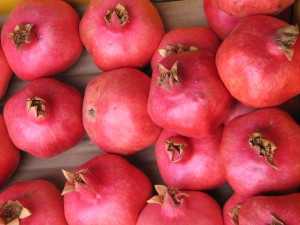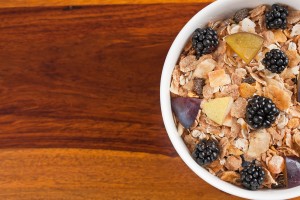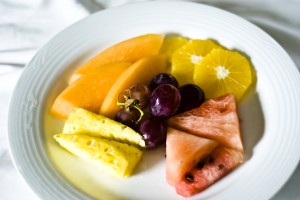 Last month, Melissa discussed two important reasons not to drink soda, high fructose corn syrup and caramel coloring. Read on to learn three more reasons to avoid this unhealthy drink.
Last month, Melissa discussed two important reasons not to drink soda, high fructose corn syrup and caramel coloring. Read on to learn three more reasons to avoid this unhealthy drink.
Reason #3: Phosphoric Acid
Phosphoric acid is a flavor additive used to give sodas their tangy, sharp flavor. It’s an acidify agent, and it helps slow the growth of mold and bacteria which would otherwise multiply rapidly in the sugary solution. It makes soda more acidic than lemon juice or vinegar, and this is why soda can essentially be used to remove rust or the scum build up around your toilet! I actually saw this demonstrated on the Nake Berkus Show.
Phosphoric acid consumption is linked to lower bone density. The reason being when your body becomes acidic, it will work to neutralize the acidity by pulling calcium from your bones. Not surprisingly, opposing studies funded by Pepsi show otherwise. Hmmm…
While I care very much about my bone health, the fact that you can use soda to clean the scum around your toilet bowl is reason enough for me not to drink it!
Reason #4: Natural Flavors
Don’t be fooled by the term “natural!â€Â Food manufacturers play tricks with our perceptions of what words mean. As a health-conscious consumer, if you see a label that says “natural†you are more likely to buy it because you think it’s good for you. But just because a food label has the word “natural†on it doesn’t mean it’s healthy! Mercury, cocaine, marijuana, and alcohol are all “natural,†but that doesn’t mean you should put them in your body!
Food companies can use the umbrella term “natural flavors†in place of a list of ingredients that the FDA claims are Generally Regarded as Safe (GRAS).  In other words, if an ingredient is on the GRAS list, companies are not required to list the additive on their label.
But here’s the thing. Ingredients like aspartame, acetaldehyde, acetic acid, and agar, which are associated with a host of health problems, do not have to be listed because they are GRAS. And there are hundreds of other GRAS additives that don’t have to be listed that you are probably eating every day!
An additive is only removed from the GRAS list when there are enough mounting reports citing its harmful health effects. But how are we to know what specific additives are making us sick when they don’t have to be listed on the label? How do we know which additives are being put in soda? When you look at the ingredients in soda you might say “there’s only 6 ingredients in here—not too bad!â€Â But how many ingredients fall under the term “natural flavors?â€
What’s even more disturbing is that, in the interest of saving time and money, the FDA allows food and additive manufacturers to provide their own “evidence†to show the safety of their additives. So these companies basically get to determine their own GRAS status.
You have to be your own health detective and do your own research; you can’t always rely on what the term “natural.â€
Reason #5: Caffeine
It seems everyone loves their caffeine! When I work with clients, I find that caffeine is one of the most difficult substances to kick. Whether it be soda or coffee, so many people rely on caffeine for a pick-me-up, and they don’t fully realize the damage they’re causing in the long run by continuing to put this addictive substance in their bodies.
Here’s what caffeine does to you, and why you should either avoid it or consume it in very limited quantities.
Caffeine, like other stimulants, causes you to release serotonin (“feel good hormoneâ€), which initially leads to an improved mood and feeling more alert, but is quickly followed by a rapid drop in serotonin which leads to crashing and feeling down. This serotonin depletion sets up a cycle because the effects of low serotonin are then followed by cravings for caffeine and other stimulants to get that serotonin rush again. This pattern is essentially an addiction—you need more and more to keep getting the desired effect.
Use of caffeine can make you dependent on other stimulants to repeat that rush of serotonin. This is why you may find that your cravings for caffeine are coupled with sweet cravings. This is also explains why when you try to quit one addiction i.e. caffeine, your body demands that you replace it with another i.e. sweets.
The continued use of caffeine disrupts your blood sugar levels and hormones, exhausts your adrenal glands, and depletes your serotonin supply setting the stage for fatigue, sleep disturbances, weight gain, anxiety, depression and other related health problems. Not to mention that your body becomes malnourished when you’re relying on caffeine and/or sweets to fuel it, as they offer no nutritional value.
According to Dr. Schwarzbein, author of The Schwarzbein Principle, there will come a time (if it hasn’t happened already) where caffeine no longer gives you the boost that you need, no matter how much you drink, because your serotonin supply in your brain has been used up. And when you end up serotonin depleted, you become extremely depressed and possibly suicidal.
I personally do not consume soda or coffee at all, and I find that it’s very challenging for people to consume these stimulants even in small doses because of caffeine’s highly addictive properties. As someone who used to be caffeine-dependent, I have firsthand experience with the scenario I just described above; in conjunction with my caffeine habit I developed insatiable food cravings and I did not feel emotionally balanced. In some cases, you’re far better off just not putting it in your body at all!
To kicking soda,
Melissa Koerner
www.FriendYourBody.com






According to this anti-soda website, soda is NOT more acidic than lemon juice and equal or less acidic than vinegar:
http://quittingsoda.com/post/the-acidity-ph-of-soda-pop
Hi Tom,
Thanks for your comment.
Lemon juice has a pH range of 2.0-2.6 and vinegar has a range of 2.0-3.4. Coke can be as acidic as 2.5, so in some cases, it can be slightly more acidic than lemon juice and vinegar.
Melissa